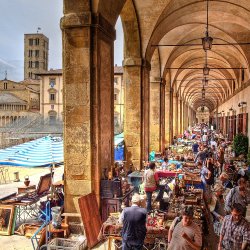8 itineraries to discover Valdambra
A guide to exploring the best of the Bucine area
This is not the first time we're advising you to travel on foot in Tuscany. Walking is a wonderful way to get to know the very best of an area. By taking a slower pace, you can better admire unique landscapes and artistic and historical treasures. This is the case in the Valdambra, a valley that takes its name from the stream of the same name that continues on in the area of Arezzo.
This valley, known for the cultivation of cereals, tobacco and sunflowers, has been inhabited both in Roman and Etruscan times. The hills still contain castles, towers, parish churches and medieval villages.
Bucine is undoubtedly the heart of the Valdambra, a town rich in large vineyards and olive groves; a city that becomes a testament for the philosophy of slow living and for being in contact with nature.
To discover Bucine and its surroundings, we recommend 8 thematic itineraries, suitable for lovers of good food, history and the traditions of Tuscany.
-
1.The Via della Ginestra
-
2.Terrace on the Valdarno
-
3.The wine route
-
4.The path of the 4 villages
-
5.Via dei Corbezzoli
-
6.The historic heather street
-
7.Through the sacred and the secular
-
8.Journey towards the source
The Via della Ginestra

From Bucine, you can take the Via della Ginestra, or the path that arrives in front of the centuries-old Sanctuary of Santa Maria della Ginestra. To get there, you take country paths, walking among vineyards where you can see villas nestled in the cypress trees. The destination of the itinerary is a well-known place of worship, next to which an Etruscan well has been found.
Terrace on the Valdarno
Another itinerary brings you to discover Pogi and its Romanesque bridge: a bridge that over the years has seen many pilgrims, travelers and merchants cross on foot or in carts, moving slowly and surpassing many difficulties.
Walking among gorse plants, oaks and olive trees, you arrive at the entrance to Montozzi castle, a magnificent terrace overlooking the Valdambra and the Upper Valdarno.
The more intrepid explorer can also make a detour to admire the gigantic holm oak of Bellavista, which boasts the venerable age of three centuries.
The wine route

Bucine, as menetioned, is an area rich in vineyards from which an excellent quality wine is produced. In the towns of Torre, Galatrona, Cennina and San Leolino, you can taste the best nectars in Tuscany, also appreciated by the Medici family. See here the itinerary between olive trees and Mercatale Valdarno.
The path of the 4 villages
The trail through four towns in the Valdambra is quite demanding compared to the earlier itineraries. It leads you to discover the great historical and landscape wealth of the Valdambra. In particular, you will get to know four small towns in the area: Capannole, Castiglion Alberti, Badia Agnano, Villa.
Of note are the remains of a Roman villa found near Capannole which once played a strategic role for commercial and military reasons.
Via dei Corbezzoli

The via dei corbezzoli is a more demanding route, not so much for its length as for the initial altitude difference that the traveler has to face. The starting point is the town of San Martino; the itinerary then winds through the woods among holm oaks, flowers and fragrant plants. You walk along an ancient ridge road that connected Valdambra with Chianti, and more recently the cities of coastal Etruria with those of the surrounding area.
The centers of Cennina and Duddova meet. The former boasts a castle which, for hundreds of years, has been disputed between Siena, Arezzo and Florence.
The historic heather street
The historic heather street begins in the town of Ambra, which bears the same name as the stream that crosses the valley. A large Etruscan settlement was found right here which testifies to how many times Valdambra has been inhabited since ancient times.
Among heather and oaks, we arrive at Poggio Castiglioni, another location where interesting Etruscan remains have been found. The road descends upon olive groves and vineyards until we arrive at the town of San Pancrazio. Finally, Gavignano gives us an additional picture-perfect view of the Tuscan landscape.
Through the sacred and the secular

A further itinerary begins in the abbey of Badia a Ruoti where it's possible to admire 15th-century frescoes with vivid colors, representing the Virgin Mary in a circle of angels and saints. Continue the journey to where Sogna and Rapale meet. Here, the roads follow the natural course of the ridge and are ideal for riding on horseback or by bicycle. Also in this area, numerous Etruscan and Roman finds have been found.
Journey towards the source
The last itinerary begins near the parish church of Santa Maria in Altaserra, built on a place known since Etruscan times, as recent archaeological excavations testify. From here, in just a few minutes you can reach Montebenichi, the castle where the brave and valiant Captain Goro lived in the first half of the 16th century. Among the cypresses and olive groves, there is also a chapel dedicated to San Francesco.
Continue towards the small town of San Vincenti and then return to the starting point.
In this article, we have recommended the 8 itineraries contained in the guide Il Diario del Viandante, from the municipality of Bucine. On the official website, you can find details on the routes, useful information and downloadable maps.
















































